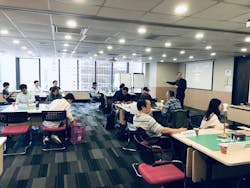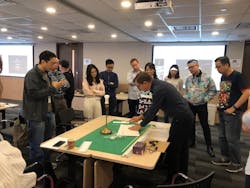The No. 1 Reason Companies Don’t Make Great Products—and What to Do About It
Companies are in business to be successful. Their goal is to create great products, enjoyed by throngs of happy customers. It sounds like such a simple concept. So, why does it turn out to be anything but? How come so many companies have trouble designing good, let alone great, products?
Granted, the playing field has changed. Brands are competing in an ever-more discerning global marketplace, and there’s increasing pressure to create new products that can disrupt the status quo.
But this accelerating consumer demand tells only part of the story.
The bigger reason companies have trouble designing great products can be related to how traditional product development is structured. Typically, the process revolves around these three fundamental components: design, engineering, and business. Designers contribute by focusing on desirability which, generally speaking, is a function of its functionality and emotional value to the customer. Engineers contribute by focusing on feasibility. They answer questions such as, “Can we make it?” and “How can we make a lot of them?” Finally, the people on the business-side drive the program and take the lead on the broad issue of viability, from manufacturing to marketing to profit margins.
To be successful, the product development process must incorporate, respect, and even appreciate all these perspectives. But is that what normally happens? Unfortunately, it’s not. What I have seen time and time again is that in the corporate setting, each one of these components—design, engineering, and business—works more or less independently, isolated within its own silo and operating in tension the other silos.
For example, engineers may spend days or weeks in their silo finetuning a product based on customer feedback only to learn later that the company accountants, who had been simultaneously hard at work in their own silo, reduced the budget for all product improvements. It’s this lack of communication and integration that leads to disgruntled employees, uninspired products and, ultimately, customer dissatisfaction. It’s the main reason so many products fail.
What can you do to change this dynamic? How can your company improve its product development process?
Best-case scenario, you break down the silos completely. But I realize that in most companies that is not necessarily practical, nor likely. So I suggest starting with this smaller, and yet potentially quite significant, step:
Form an Integrated Product Development Team
A product development team should be flexible enough to work within any silo. This team will act like a thread stitching together the silos into a seamless mesh. Your integrated product development team should be somewhat intimate—less than 10 people—and nimble. In addition, it must be:
Diverse. The team should include experienced practitioners from a variety of disciplines, beginning with the core three: design, engineering, and business. You will also need the kind of cultural and ethnic diversity that reflects your customer and/or marketplace. All companies, but especially those that sell internationally, must recognize that the user experience needs to be continually filtered through a variety of lenses.
Willing to engage with customers. Members of your integrated product development team need to be comfortable getting out from behind their screens and engage with customers in the field. A product’s whole purpose is to deliver value, and talking to customers about the user experience is one of the best ways to learn how your products are measuring up.
And remember, great products provide both emotional and functional value. Functional value tends to be binary—either your product does its job, or it doesn’t. Emotional value is more nuanced and, despite how subjective it may seem, usually serves as the driving force behind how consumers differentiate between which products to buy. Study after study has shown that emotions compel people to action and influence their purchasing decisions; that’s why keying in on emotional value can be so beneficial to product development.
Resilient. Team members must be able to overcome a variety of challenges, which initially may include language barriers, communication bottlenecks, and even credibility issues. Moreover, they have to be able to accept, and then learn from, the occasional setback. In the end, that's how great products are developed—you try, fail, try again, fail again, and just keep going. Companies and teams that value and nurture this type of approach understand that there is no single, surefire recipe for success. It’s a process and it’s done together.
Tasked with consensus. Perhaps most important of all, members of your integrated product development team need to work from a shared vision, building consensus as they move forward. That means no one gets to retreat to the comfort of their silo. Designers have to relate to engineers. Engineers have to relate to designers. The business folks need to hear feedback, and they need to be heard, as well. In other words, the team needs to be mindful and appreciative of one another, and once that starts happening, the process—rather than a person—takes the lead. If you want to create products that customers will find truly innovative and worthwhile, there has to be this kind of give and take and a commitment to, in the end, do what needs to be done to improve the user experience. At the highest level, teammates admire each other’s super powers, empower each other, and trust each other explicitly.
When it comes right down to it, products are experiences. Empower your integrated product development team to explore the experience you’re delivering from all angles. Then, have them take what they have learned back to their respective disciplines. When product development is governed by this type of collaboration and cooperation, the results can be extraordinary. You might just find that your company creates something great, a product that improves the bottom line, works well, and not only satisfies your customers, but brightens their lives.
Matthew Kressy is founding director of the MIT Integrated Design & Management (IDM) master’s degree. Check out his MIT Professional Education summer course, Design-Driven Innovation.
About the Author
MIT Insights
MIT Insights: Helping Professionals Think, Learn, Work
MIT Professional Education is a gateway to renowned MIT research, knowledge, and expertise. Advanced continuing education courses on cutting-edge topics, such as artificial intelligence, additive manufacturing, and computational design provide lifelong learning opportunities for science, engineering, and technology professionals at all levels. This series explores some of the Institute’s most in-demand course offerings and spotlights expert faculty instructors who are looking to share industry expertise in order to drive innovation.



